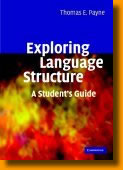Exploring Language Structure: A Student's Guide
|
Designed for those beginning to study linguistics, this is a lively introduction to two key aspects of the structure of language: syntax (the structure of sentences) and morphology (the structure of words). It shows students in a step-by-step fashion how to analyze the syntax and morphology of any language, by clearly describing the basic methods and techniques, and providing almost 100 practical exercises based on data from a rich variety of the world's languages. Written in an engaging style and complete with a comprehensive glossary, Exploring Language Structure explains linguistic concepts by using clear analogies from everyday life. It introduces a range of essential topics in syntax and morphology, such as rules, categories, word classes, grammatical relations, multi-clause constructions and typology. Providing a solid foundation in morphology and syntax, this is the perfect introductory text for beginning students, and will fully prepare them for more advanced courses in linguistic analysis.
This textbook is boldly methodological, typologically based, and theoretically informed. The tone and style of this work are designed to engage undergraduates while leading them into a solid understanding of some rather challenging material. Analogies from everyday life are used to explain concepts that undergraduates often find perplexing. For example, on page 1 language is presented as a tool for communication. Even as a common tool, such as a hammer, has a form and a function, so language has form and functions. Many of the features known to be common to human languages can be insightfully understood in terms of this simple analogy. Recent work in Learning Theory (e.g., Holyoak, Gentner and Kokinov 2001) have shown this approach to be particularly effective in communicating complex material, especially at the undergraduate level.
A major motivation for this book is that there are very few introductory texts that combine morphology and syntax. This is in spite of the fact that it is becoming common practice to combine the two in professional linguistic research. The increasing use of the term "morphosyntax" testifies to the fact that morphology and syntax are being viewed as a unitary whole. Other undergraduate texts in linguistics are either general introductions to the entire field, or works dealing with specific subdisciplines. This book is theoretically informed, but not burdened with the theoretical controversies that linguists are so fond of, but which undergraduates often find arcane.
The book is organized into two broad sections, corresponding to morphology (5 chapters) and syntax (6 chapters). Each chapter consists of text, a conceptual outline and exercises. The text descibes various aspects of grammatical structure and techniques for analyzing such structures and representing them in concise written form. Linguistic theory is discussed as it bears on analysis of linguistic data. A conceptual outline summarizes each chapter, and provides a hierarchical display of the main points. This innovation has been instituted on the suggestion of students, who find this type of outline helps them assimilate the material in the reading. Finally, the rich array of classroom-tested exercises give students practice in implementing the methods and concepts introduced in the chapter text. Most of the exercises are sets of linguistic data presenting some analytical problem raised in the body of the chapter. These problem sets have been collected over many years, and represent dozens of languages, covering every region of the inhabited world.

